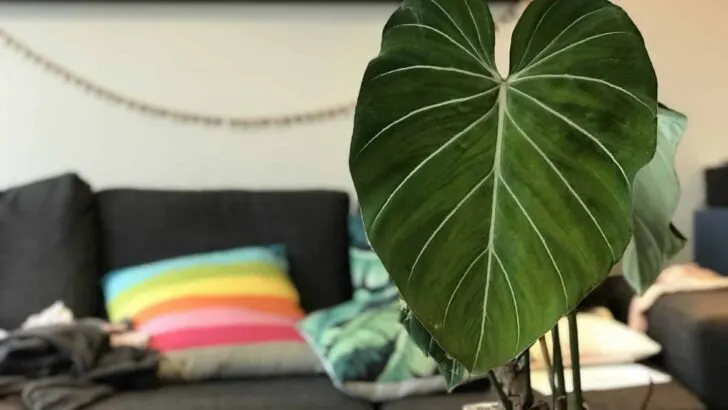You are here because you want to know how to care for a Philodendron gloriosum. This velvety Philodendron is rare. It is not difficult to care for, however. I have multiple plants at home and propagated them multiple times.
My main goal now is growing and growing bigger leaves. Here is what you need to know to grow these houseplants successfully.
Philodendron gloriosum Care Takeaways
| Species | Philodendron gloriosum |
| Synonyms | Anthurium Gloriosum, Creeper Plant, Velvet Philodendron |
| Family | Araceae |
| Genus | Philodendron |
| Growth | Crawler |
| Height | 2.95 feet |
| Width | 3 feet |
| Soil | Well-draining soil containing peat, perlite, charcoal, and orchid bark |
| Watering | Water every 5 to 7 days |
| Light | Bright indirect light |
| Temperature | 65 to 85°F |
| Humidity | 60-80% |
| Fertilizer | Fertilize 1 times per month |
| Propagation | Rhizome (stem) propagation, seeds |
| Toxicity | Toxic to people and pets such as cats and dogs as it contains calcium oxalate crystals |
Table of Contents
Philodendron gloriosum Care
Philodendron gloriosum grows best in well-draining soil containing peat, perlite, charcoal, and orchid bark. Alternatively, it also grows in 100% sphagnum moss. Provide bright indirect light and keep the soil slightly damp when watering. Before watering, make sure the top 1-2 inches of soil are dry. The ideal temperature range is between 65-85°F (18°C – 29°C). Use liquid fertilizer at half-strength monthly in spring and summer and reduce it to every eight weeks in autumn and winter. Increased humidity between 60-80% can be provided for best results.
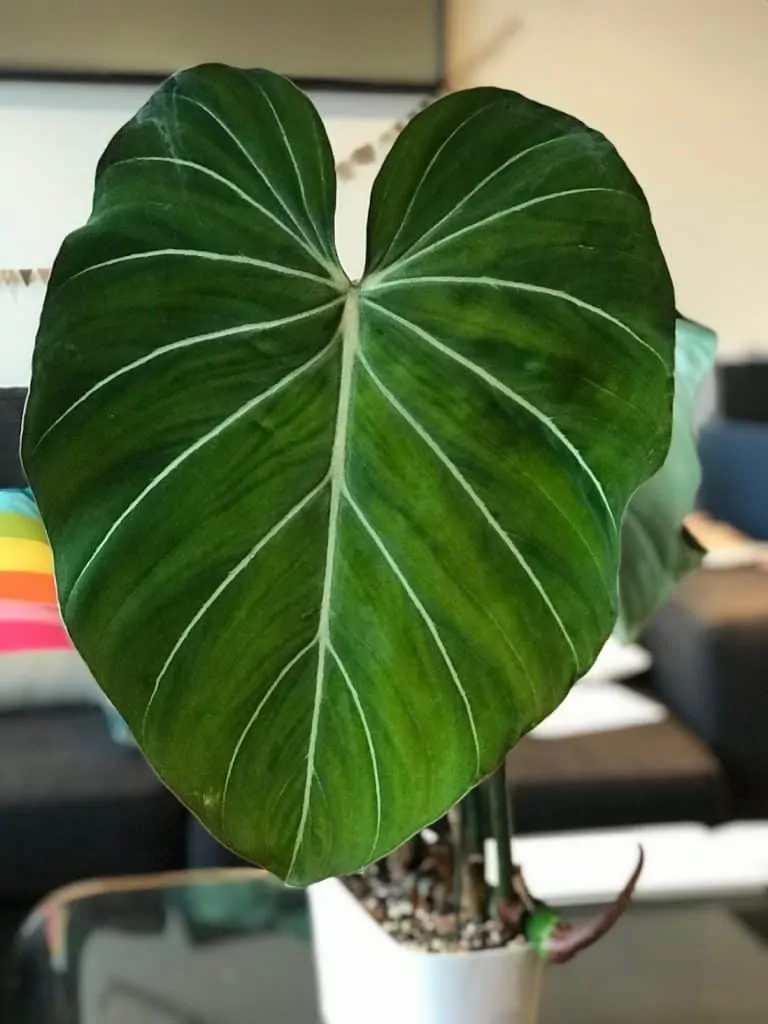
The Philodendron gloriosum Plant
The velvet-leaf Philodendron is a tropical plant native to Colombia, Mexico and Central America, Peru, Ecuador, the western parts of Brazil, and Venezuela.
with velvety green leaves that are heartleaf-shaped with pale to striking white veins. The plant belongs to the Araceae or Aroid family and is within the Philodendron genus. It is a terrestrial plant that is creeping. As it is not a climber, a moss pole is unnecessary.
By crawling, I mean creeping on the ground. Its stem grows horizontally along the surface.
It is, therefore, important to provide a narrow container long enough for this terrestrial Philodendron to crawl.
Caring for an philodendron gloriosum
Philodendron gloriosum soil mix
Choose well-draining soil that is rich in organic matter. A soil pH level between 5-8 is best.
You can use an orchid potting mix and add peat and perlite to lighten the soil and create better aeration.
Oxygen is essential for the roots. Many tropical plants rely on airflow. Poor drainage caused by the wrong soil will lead to root rot.
A further ingredient in many aroid mixes is horticultural charcoal. It is said to sweeten the soil and remove toxins.
One may ask why on earth a plant would appreciate having charcoal in its soil.
The reason is quite simple. You should always try to imitate the natural habitat of the plant you are growing as well as possible.
Forests burn down naturally from time to time caused by wildfires. Charcoal, the product from burned down trees, is therefore present in the natural habitat of Aroids.
If the soil is dense, it may cause the roots of the Heart-leaf Philodendron Gloriosum to suffocate and lead to root rot.
It is also possible to grow the Gloriosum in 100% Sphagnum moss. However, ensure to fertilize your plant occasionally, as the moss contains no nutrients.
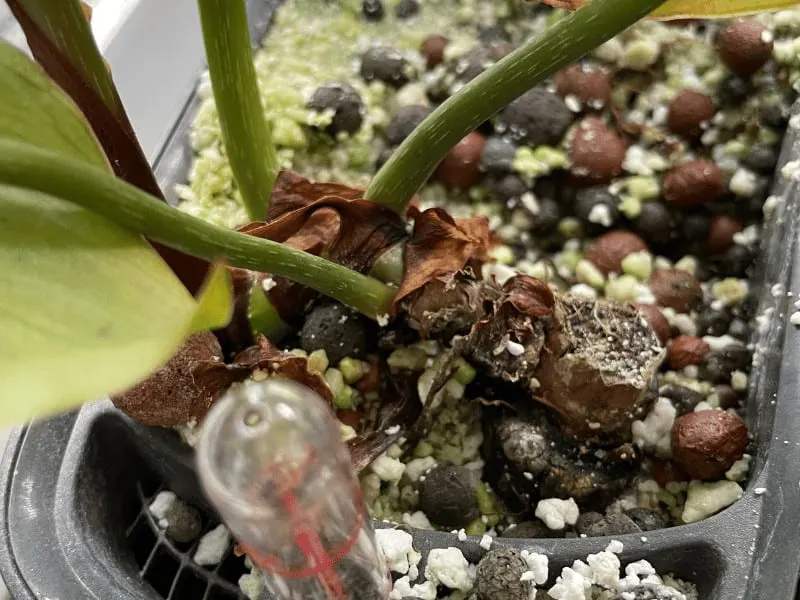
Philodendron gloriosum light
Bright indirect light is best for a Philodendron gloriosum.
There is a big debate in the aroid collectors world about whether shade, semi-shade or a bright spot leads to better-growing conditions for your Philodendron.
Based on my experience, these plants grow best close to a window with bright indirect light. Too much direct sunlight will lead to yellow leaves and damage your plant.
It is said that shade is best in perfect conditions in the natural habitat. If you are growing a Elephant Ear Philodendron, you will not even come close to conditions that are perfect for your Gloriosum.
A further effect of lots of light I observed is bigger leaves. The Gloriosum is all about big velvety, nicely veined leaves.
Long leggy petiolesa and stems, as well as big distances between leaves can be indicators that your plant is not getting enough light.
Place your plant closer to a window but ensure the sun rays do not touch the leaves directly.
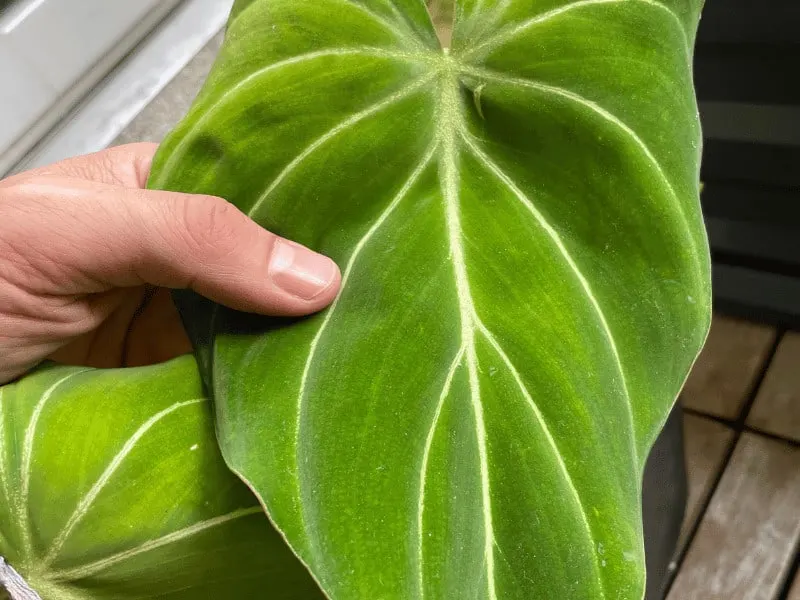
Watering
Keep the soil damp but not soggy, and water once the top 1-2 inches of soil are almost dry. The Gloriosum is a plant that prefers slightly moist soil, but you should not overdo it as this can lead to root rot.
In spring and summer, water about once every seven days. Reduce watering in autumn and winter to every ten days or more.
In case you spot signals such as mushy roots, or yellowing leaves show signs of overwatering and likely root rot.
Philodendron plants are susceptible to overwatering.
Do not worry too much as This Philodendron will survive if you overwater it once or twice.
If you overwater your plant, the roots might be unable to intake more water. The leaves of your Philodendron will droop.
Droopy leaves can be a sign of over- or underwatering.
If you do not water sufficiently, this plant will also indicate it by dropping leaves.
The best indicator will be to stick your index finger into the soil to know if you should water it.
Generally, the top 1-2 inches of soil should be dry or almost dry before watering.
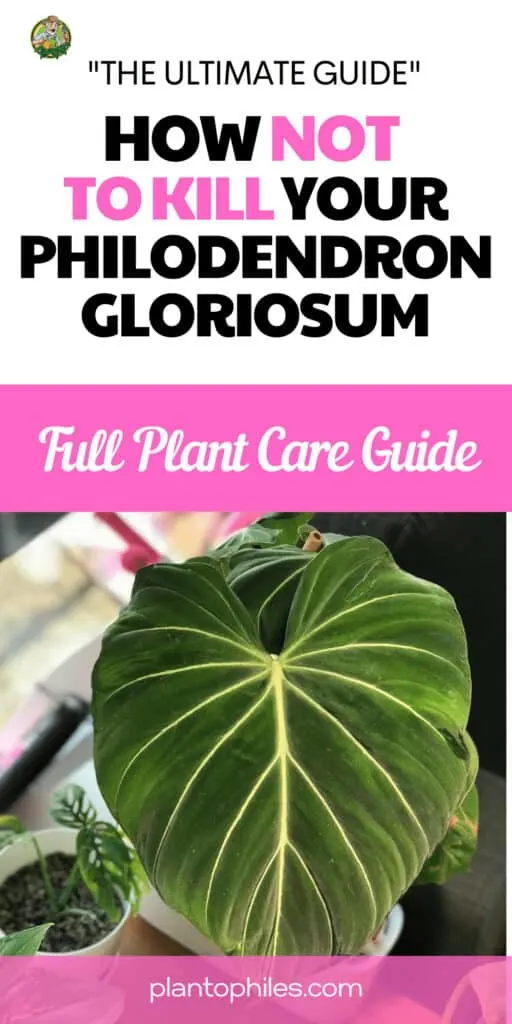
Temperature
The best temperature range is 65°F to 85°F (18°C – 29°C). Night temperatures between 60°F to 70°F (16°C – 21°C) are ideal.
The plant grows in USDA hardiness zone 11, according to the plant hardiness zones of the United States Department of Agriculture
Philodendron gloriosum Humidity
As a rainforest plant, Philodendron gloriosum thrives in slightly higher humidity, between 60-80%.
They can also take humidity of around 40-50% if they have to, but it is certainly not ideal.
If the humidity is below 40%, you must consider using a humidifier indoors.
In summer, it is important to ensure the Sweetheart Plant is away from air conditioning, and in winter, it needs to be kept away from radiators.
Both of these will dry out the leaves and the Gloriosum itself.
Some people put a tray with water close to this Philodendron or a pebble tray with water underneath the pot.
Both methods will increase the humidity and are far better solutions than misting your Philodendron.
Fertilizer
Use liquid fertilizer at half-strength monthly in spring and summer and reduce fertilization to every 8 weeks in autumn and winter for Philodendron gloriosum.
The correct amount of fertilizer is critical for good plant growth and bigger and bigger Gloriosum leaves.
Slow growth and small leaves might indicate that your plant lacks essential nutrients.
The Gloriosum is generally a fast-growing plant that produces at least 1 leaf a month on average.
Growth
Philodendron gloriosum is a slow grower. It often takes more than a month from seeing a leaf spike (cataphyill) to the plant revealing a new leaf.
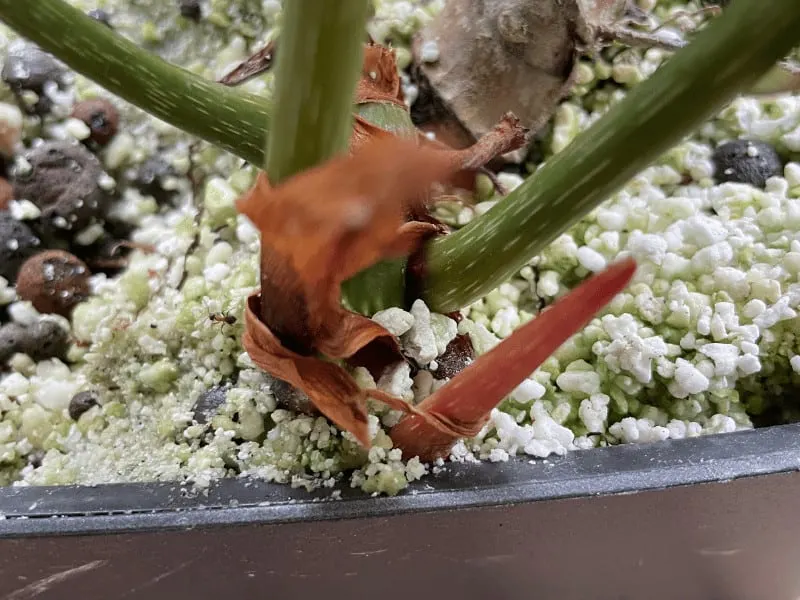
The leaves of this plant can’t get up to 26 inches (90cm) in its natural habitat, according to the Exotic Rainforest website.
The leaves start in a cataphyll that looks like a red spike. The leaves are rolled and unfold once they grow larger.
The Gloriosum has a rhizome that grows along the soil from where the leaves emerge.
In addition, Philodendrons can be propagated by pollination and grown using seeds.
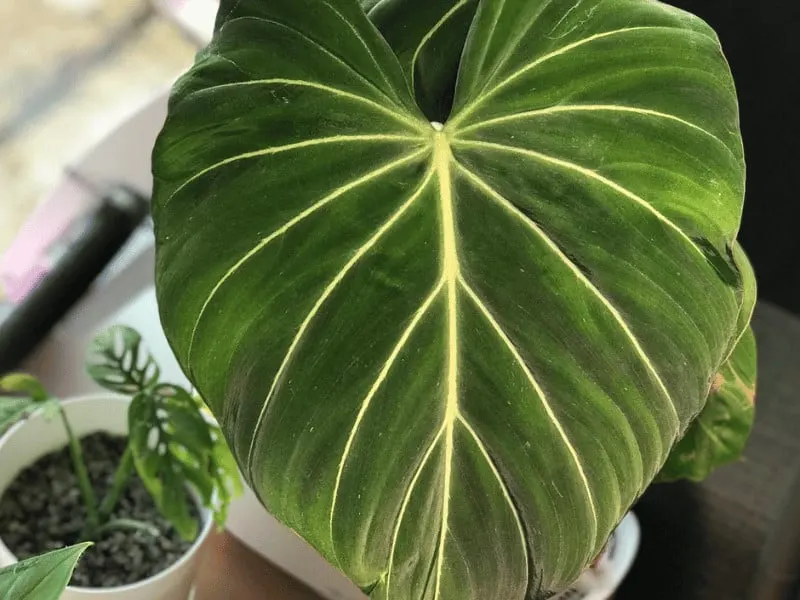
Potting
Use a pot with drainage holes and well-draining soil; you do not want your Philodendron to sit in water. Drainage holes will enable excess water to drain quickly.
The best-suited pots for these plants are not round but rectangular and as long and narrow as possible. As Gloriosum is a crawling Philodendron. Its’ growth pattern is to creep along the soil and will soon reach the end of a conventional round pot.
Once it is hanging over the edge, the plant can no longer grow roots in the soil, and the leaves will become smaller again.
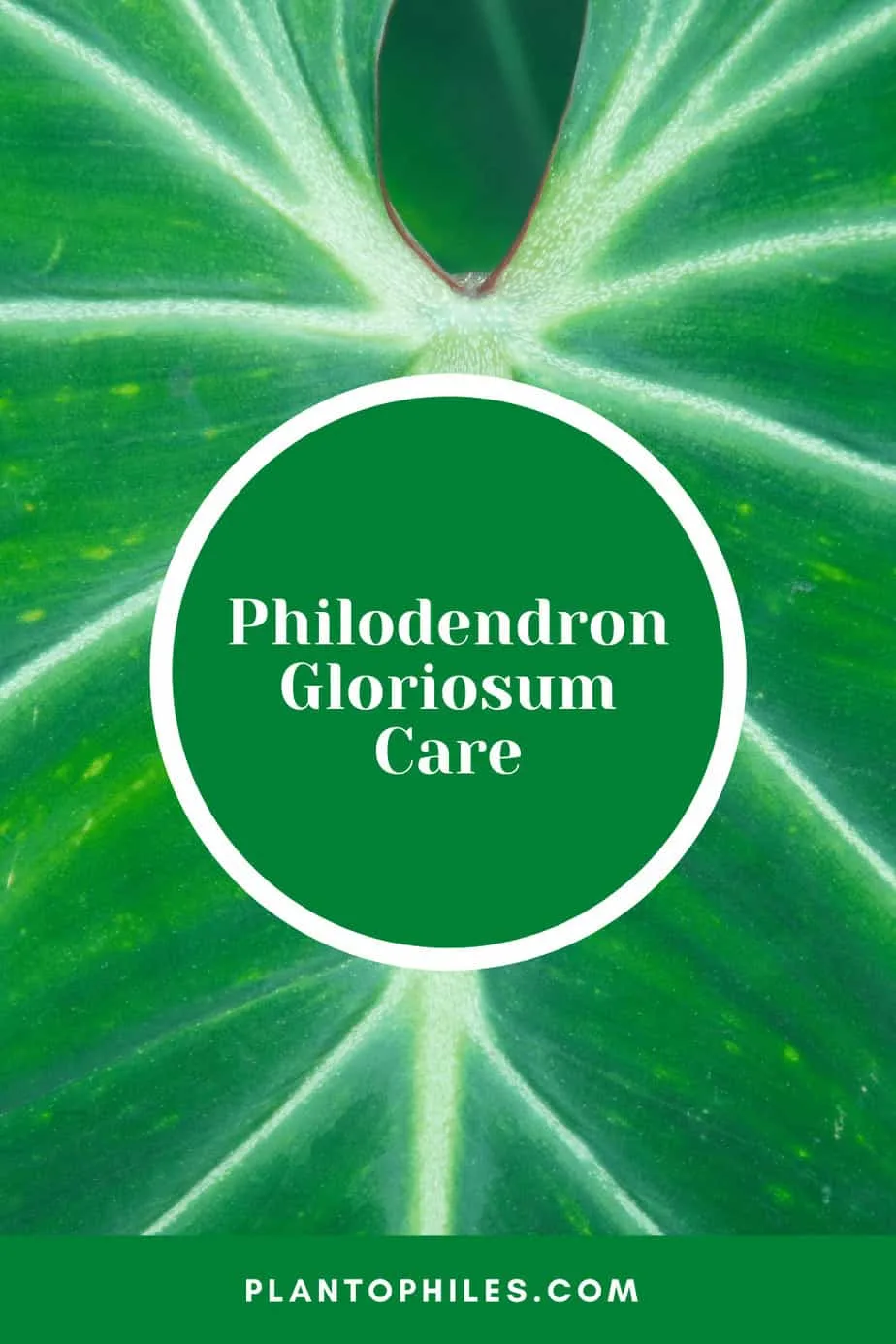
Planter
The best planter for a Ph. gloriosum is as long, narrow, and shallow. Round pots are not suited, and the pot itself doesn’t need to be very deep.
It doesn’t matter if you use a plastic or ceramic pot.
I use the Lechuza Planter Delta 20 as it is long, narrow, and semi-hydro.
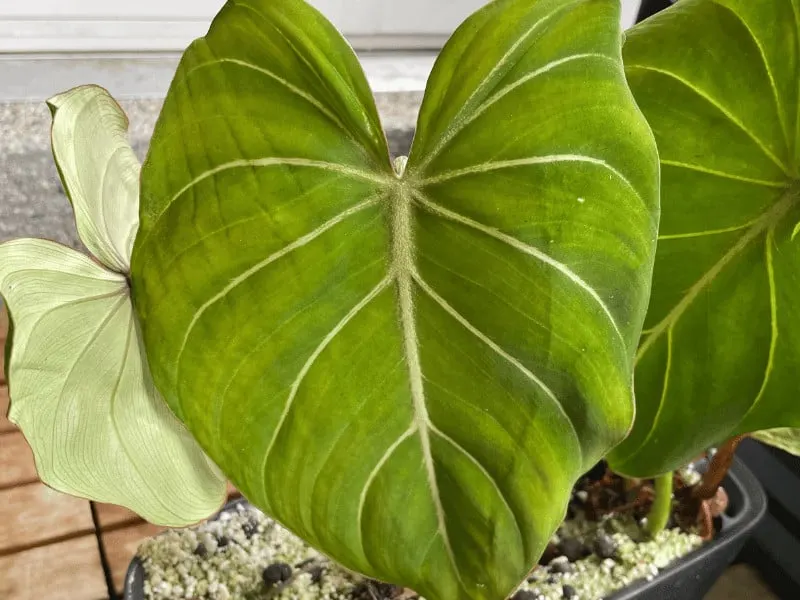
Lechuza Pon also works great as a substrate for Ph. Gloriosum.
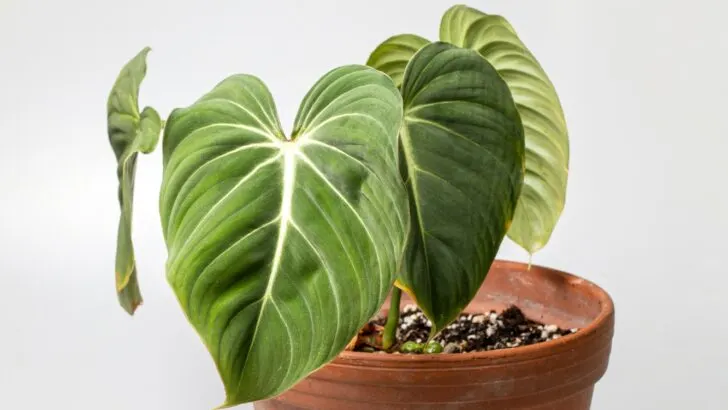
Philodendron gloriosum flower
The Gloriosum flower is white and consists of a spathe and a spadix. Under good care, you will see your plant flowering once it matures.
The Gloriosum flower goes through male and female anthesis. The female anthesis comes first.
Once it starts, the plant will produce sticky sap on the white flower. This is the time the Gloriosum can be propagated using pollen.
After the female phase, the male phase starts, where the Gloriosum will start to produce pollen that can be collected.
The flowering will last several days and weeks. However, the male and female phase will only last a few days, especially the female phase, which is easy to miss.
The Gloriosum is only receptive when there is sticky residue and plant drops on the spadix.
Philodendron gloriosum outdoor care
This plant can be grown outdoors in USDA hardiness zone 11. The temperatures should be between 65-85°F (18°C – 29°C).
These tropical plants do not take cold well and will discolor and turn red when temperatures are below 50°F for several days.
When planting the Gloriosum outdoors, choose a spot with bright indirect light. This is usually a spot in the garden with light shade from bigger plants such as trees and shrubs.
Gloriosum does not take full sun very well outdoors.
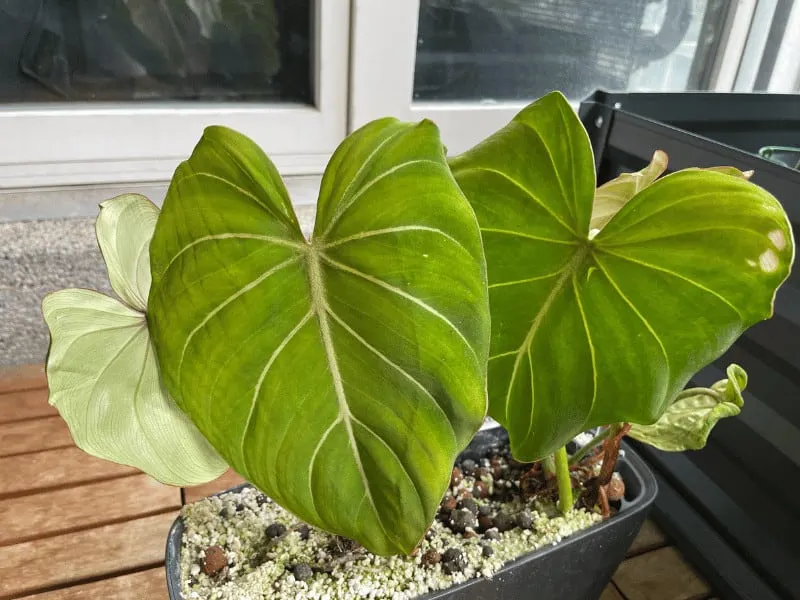
The Rhizome – Above or below the soil
When I got my first Gloriosum, I was clueless about what to do with the rhizome. The rhizome is part of the stem from which the leaves emerge.
This was my first creeper, and I was unsure. Should I bury the rhizome in the soil or keep it above? I even had the rhizome vertically at one point as all my experience was based on climbing Monstera and Philodendron species.
The answer is simple. Keep it above or slightly below the soil for even better growth. It is supposed to be on the surface of the soil or in the soil so the roots can grow into the soil.
The upper half of the rhizome should remain exposed.
The problem with a buried rhizome is that it is more likely to rot if the soil stays moist.
When the rhizome is not touching the ground, the roots cannot grow into the soil. So putting it horizontally or having it creep out of the pot will lead to smaller and smaller leaves.
For the best growth, the rhizome needs to stay at least partly above ground, and the roots need to be able to find their way into the soil.
How does a new leaf on a Philodendron gloriosum look like?
Gloriosum leaves grow in a cataphyll. This is an elongation of the stem. It is dark red to brownish with white lines sprinkled across it.
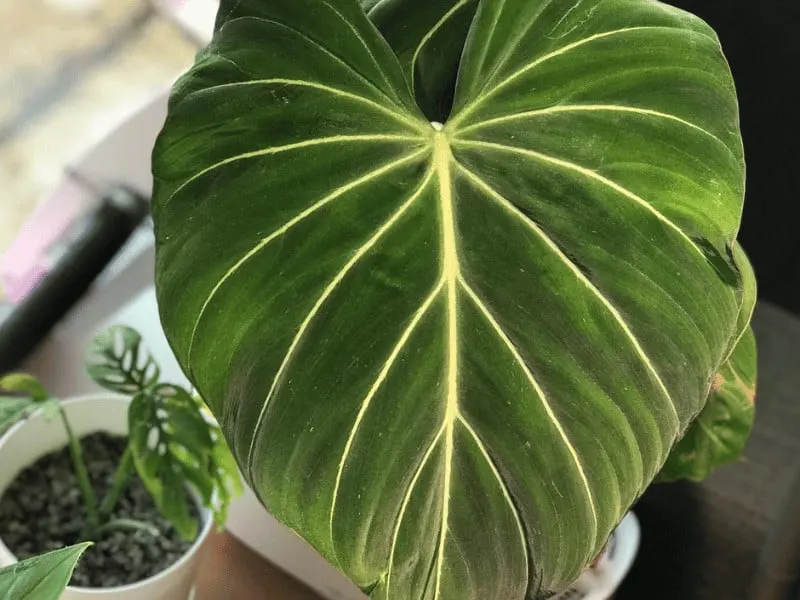
Once a new leaf grows on this Philodendron, the cataphyll will get larger and larger until a leaf emerges from it and then starts to unfurl.
The new leaf is completely rolled up in the cataphyll and starts to unfurl once it leaves it.
The Gloriosum leaf unfurling offers quite a show and can take several days to weeks.
The bigger the cataphylls, the larger the leaf will be.
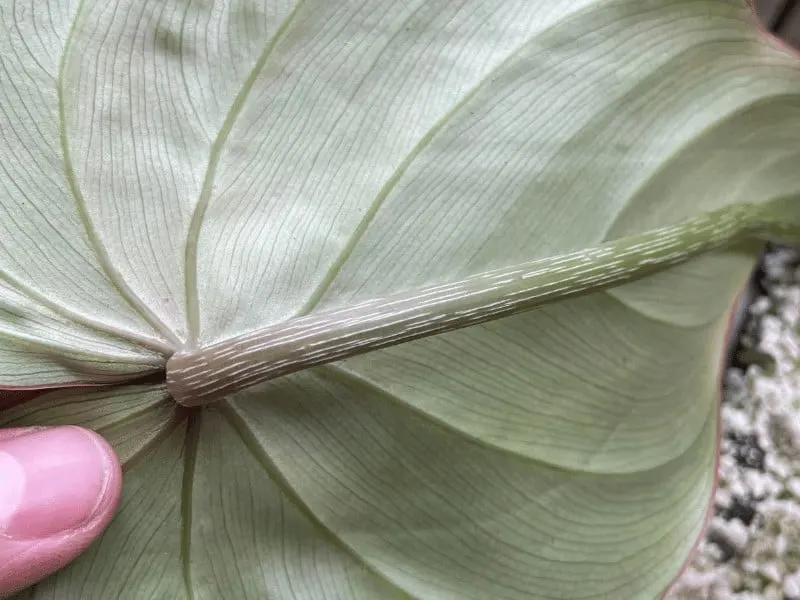
Philodendron gloriosum Propagation
Philodendron gloriosum is best propagated by stem cuttings. The sections between leaves can be used to grow new plants.
The biggest advantage is that the rhizome stays in the soil and will grow roots down into the soil. Once you are taking a stem cutting from the rhizome, your cutting already comes with roots in many cases.
Lets now dive into the step-by-step instructions on how to propagate Philodendron gloriosum:
- Find a suitable section on the rhizome between two leaves on the rhizome
- Make sure to leave at least three leaves on the remaining mother plant
- The cutting itself can have leaves on it, or it can just be the rhizome itself.
- Cut the rhizome with a pruning shear to ensure the cut is clear and even
- Once the rhizome has been cut, let the cutting callous over for a couple of hours
- Put some cinnamon on the cutting. It acts as a disinfectant and will help the wound to heal
- After several hours (depending on the thickness of the cutting), you can proceed with the next step
- Use a pot (I prefer plastic pots) and put some moist (not soaking wet!) Sphagnum moss in it
- Gently put the cutting into the moss
- If you can, put the pot with the cutting either into a plastic container or put a plastic bag onto it
- Open the lid or the plastic bag every couple of days for a few minutes, so the air does not go stale
- The increased humidity will help the plant to grow roots
- This can take anywhere from 2-4 weeks. We prefer to support the process by putting a seedling heat mat underneath a plastic box as the increased warmth from below speeds up the process considerably
- Once you have considerable roots on your cutting and the first 2-3 leaves have grown it will be time to pot the cutting into a pot with potting soil
- Congratulations, you just cloned one of the most beautiful Philodendrons on the planet!
We mentioned that you could take rhizome cuttings with or without leaves. The difficulty of cutting with a leaf is that it needs to stay in humid conditions so the cutting will not lose it.
The bigger your Gloriosum leaves are, the harder it will be to find a suitable container or plastic bag (transparent) to put your cutting into it.
A leaf, in theory, can be an advantage as the cutting might have more energy to grow new roots due to the photosynthesis it still can conduct.
However, there is no guarantee as cutting might also decide to abandon the leaf and use the energy to grow new roots immediately.
Propagate Philodendron gloriosum in Water
It is entirely possible to propagate Gloriosum in water. The steps are the same as propagating it using sphagnum moss or soil.
Instead of using a growing medium, you put the rhizome with or without leaves into the water.
Ensure no water touches the leaves, or they will rot.
Also, leave the chunk or rhizome for 3-4 hours or even up to 12 hours to dry so it can callous over before putting it in water.
Tap water is fine, but let it sit for 12-24 hours before putting your Gloriosum cutting into it.
Steps to propagate Philodendron gloriosum in water:
- Prepare a clean blade using rubbing alcohol and an open flame (lighter)
- Find a section with a node (this is where the rhizome is knobby)
- Cut off a section of the rhizome with a sharp kive or pruning shear
- Let the wound on the cutting callous over (at least 2-4 hours)
- Get a container and fill it with tap water that you let sit for 12-24 hours
- Put your cutting into it and make sure the leaves are above water
- Change the water every 7-10 days
- Wait for 3-4 weeks until the roots start to grow
- Once the roots are several inches long, move the Ph. gloriosum to a pot filled with potting medium (soil mix, perlite, or sphagnum moss)
- Once the cutting grows a cataphyll and then a new leaf you know it has sufficiently rooted
My Philodendron gloriosum has Yellow Leaves – Why?
The most common reason for yellow leave on Philodendron gloriosum is overwatering. When leaves are yellow, it does not always mean something is wrong. Old leaves become yellow at a certain point in time and will die. However, if younger leaves on the plant start to yellow, the causes can be manifold.
Yellow leaves can also be caused by direct light. This plant does not take direct sunlight very well. Too much of it will lead to yellowing leaves.
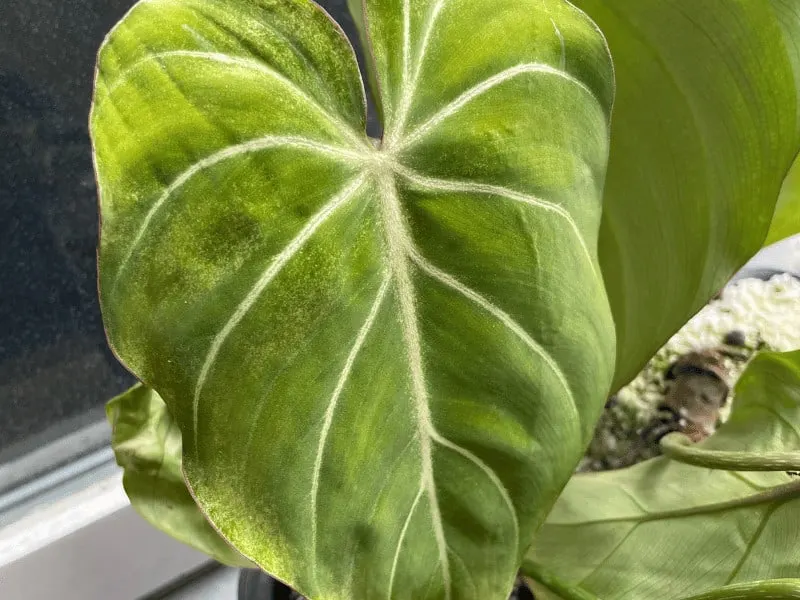
Remedy
Move your Ph. Gloriosum to a location where it gets bright indirect light and probably further away from a window it might be located.
Another reason for yellow leaves is overwatering. Provide your Philodendron with too much water, and the leaves of your plant will start to yellow. This will not affect just older leaves.
Remedy
Reduce watering. Usually, the frequency has to be reduced and not the amount. Check the soil and make sure it is only slightly moist to almost dry before watering your plant.
Check the soil mix. Is it well-draining? Is water coming out of your pot within seconds when you water? If the soil stays wet and even soggy for too long, you must invest in a well-draining soil mix using perlite, pumice, and orchid bark.
Does my Glroriosum have Root Rot?
Root rot is a cause of overwatering and soil that is too dense and stays wet for too long. Its symptoms above the soil are stunted growth, leaves that are not unfurling, and yellow leaves.
Remedy
If you suspect root rot or spot yellow leaves and are sure it is not caused by direct sunlight, checking the roots is a good idea. Root rot is life-threatening for your plant.
The disease will quickly move from the infected roots to the rest of the roots and will also be present in the soil.
Check the roots to see if they are healthy, not mushy or soft. When rotting, parts of the roots come off easily and look black or brown.
If that is the case, remove all rotting roots and cut the roots back to the still healthy parts. Then wash the roots off, change the potting mix completely, and use a well-draining mix.
Pests on Philodendron gloriosum
Plant pests are every indoor and outdoor gardener’s nightmare! It can be so tedious to get rid of these little pesky pests.
Like most other Philodendrons, such as the Heartleaf Philodendron or the Philodendron Selloum, the gloriosum is prone to pests.
The most common pests on a Philodendron gloriosum are:
- Spider Mites
- Aphids
- Mealybugs
- Scale
- Fungus Gnats
- Whitefly
Neem Oil to Get Rid of Pests
Neem oil is not cheap, but it is working wonders. It is natural, and you can spray it on your plants indoors.
This is a big benefit as you do not have to bring your plants outdoors, and you can be sure you are not inhaling anything harmful in your four walls.
Two types are available: pure neem oil or diluted one. We prefer the diluted one as you do not have to mix it again, and you can spray it directly on your plants.
To use neem oil, spray it on your Gloriosum until all plant parts are completely wet. Apply it once and then repeat the process in 2 weeks again.
This way, you can also eliminate pests that might have missed your first neem oil session as they might have been still in an egg, probably in the soil at that time.
Rubbing Alcohol Against Pests
Very effective. Use rubbing alcohol on a cotton swab and put it on your plant’s leaves, top and bottom, and on the stems of your plants to get rid of any pests. Do this for two weeks, every few days, until you cannot spot any more pests or signs of pests.
Do not lose faith. Getting rid of plant pests is not easy; some might be so small that you cannot even see them with your bare eyes.
Look out for webs and sap that have been sucked to get insights into whether plant pests are still present, although you can’t see them anymore. A magnifying glass might help as well.
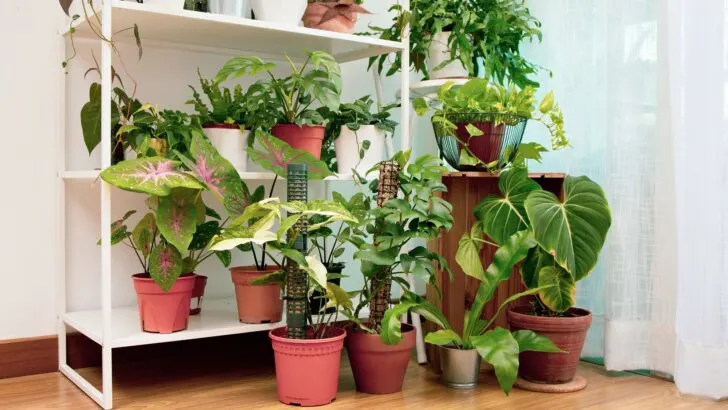
Philondendron gloriosum x Philodendron pastazanum (Philodendron Dean McDowell)
This one is a crawler. The Philodendron pastazanum has beautiful leaves on its own with their shiny bright green look.
Crossed with a Philodendron Gloriosun, Philodendron Dean McDowell gets huge pillowy leaves that are glossy and have deep white veins. It is said to reach up to 3 feet in height (91cm)!
You will also find this one named Philodendron McDowell or McDowelli. However, only Philodendron Dean McDowell is correct.
Philodendron gloriosum x P. melanochrysum (Philodendron glorious)
This is a wonderful gloriosum hybrid combining the best features of two of my favorite plants.
Philodendron melanochrysum and Ph. gloriosum.
It has the climbing habit of the Melanochrysum and the beautiful leaves of a Gloriosum mixed with some features from the Melanochrysum.
The hybrids are known to grow faster and more vigorously than both their parents while they are considered to be easier to care for.
Read more about Philodendron glorious care.
Philodendron gloriosum vs. glorious
The main difference between the gloriosum and the glorius is that the gloriosum is a crawler, while the glorious is a climber.
In addition, the glorious carries over some traits of the melanochrysum. Apart from the climbing habit, the leaves are usually darker and more elongated.
Furthermore, caring for the Ph. glorious is even easier than the gloriosum. The hybrid gets larger leaves faster, and grows more vigorously.
The gloriosum on the other hand, is no cross between two different species.
Glorious is a hybrid of the gloriosum and the Ph. melanochrysum. This means the glorious carries some of the DNA of the gloriosum and some of the melanochrysum.
Philodendron verrucosum vs gloriosum
The Philodendron verrucosum is easy to distinguish from the gloriosum. The main differnce is that the verrucosum is a climbing plant. It climbs. The gloriosum will crawl on the ground. In addition the Gloriosum leaves are more velvety and larger.
The heart-shaped form is more pronounced. Many Philodendron verrucosum cultivars have a red leaf underside.
There is a hybrid between the two that is called Philodendron gloriosum x verrucosum or Philodendron Splendid.
What is an Anthurium gloriosum?
Is there an Anthurium gloriosum? The right answer is that there isn’t. If you are reading about an Anthurium gloriosum it is most likely an honest mistake where the author wrote Anthurium instead of Philodendron in front of gloriosum.
The gloriosum plant is a Philodendron.
Philodendron gloriosum Toxicity
Philodendron Gloriosum is toxic to people and pets such as cats and dogs as it contains calcium oxalate crystals. It can irritate the throat, cause swallowing problems, oral pain cramps, and many more if ingested. It can even lead to cramps, seizures, kidney failure, and coma if ingested in vast amounts.
Therefore, keep this plant away from children, cats, dogs, and other pets.
Philodendron gloriosum Stem
This Philodendron has a rhizome growing either on the surface or slightly below the surface.
The rhizome is the underground stem of the Philodendron gloriosum.
Stems that grow under the soil are called rhizomes.
A healthy stem will be firm to the touch. A soft or mushy gloriosum stem indicates changing the soil or watering schedule.
Based on personal experience, a stem lightly under the soil will produce the best results regarding plant growth and leaf size.
However, ensure that the Philodendron gloriosum chunk is not buried too deep, which can lead the stem to rot.
Philodendron gloriosum Types
Philodendron gloriosum zebra
This gloriosum type has a more prominent veining compared to the original type. It has distinctive broad light green to white veins hence the name.
Philodendron gloriosum verde
This type has green to very dark green heart-shaped leaves. It also sports white veins but is less prominent than the Philodendron gloriosum zebra.
Philodendron gloriosum silver
This type of gloriosum has prominent silver veining once they are mature. The veining gets more visible the older the plant gets.
Philodendron gloriosum dark form
The main difference between the dark form and all the other forms is that Philodendron gloriosum dark form produces very dark green leaves. It is a rarely offered and much-desired variant. The white veining is very prominent, and the edges of the leaves are reddish.
Philodendron gloriosum white veins
This variant is a velvety beautify with striking white veins that are visible. The veins are more prominent than other variants and are a clear white compared to the greenish veins of some gloriosum variants.
Philodendron gloriosum pink back
The pink back is a variant of the Philodendron gloriosum zebra with a pinkish leaf underside. It has white veins on the adaxial leaf side and a pinkish hue on the abaxial leaf.
Philodendron gloriosum round form
This type has rounder leaves compared to the more heart-shaped leaves of the other forms. The leaves are almost circular. It is said to be even more sturdy compared to the original form.
Is Philodendron gloriosum Rare?
This Philodendron gloriosum is not exactly rare but still sports at least a two-digit price tag and can set you back even 3 digits depending on the size of the Philodendron gloriosum.
The average price for a Philodendron gloriosum is between $40 – 280 dollars. The main differentiator in the price is often the size.
A baby gloriosum can often be bought for $40-50, whereas a multi-leaved big gloriosum with a big chunk as a stem will cost up to 300 dollars.
It might not be available in supermarkets or most garden centers, but you can buy Philodendron gloriosum in the US at Steves Leaves, Etsy, Ecuagenera, and many other shops.
Frequently Asked Questions
How to care for Philodendron gloriosum?
These plants need a well-draining potting mix and humid soil. Make sure not to overwater as soggy soil will lead to root rot. The light requirements for this plant are bright indirect light if you care for your Philodendron gloriosum indoors.
Where can I buy a Philodendron gloriosum?
Philodendron gloriosum can usually not be found in your average garden center. Your best bet is to go online and try to find one on Facebook, Etsy, eBay, Instagram, or from one of the Online plant stores opening up left and right.
Is my Philodendron gloriosum dying?
Check the leaves. Are they yellow? If so, check the soil. Has it been wet and soggy for some time? If so, chances are that your plant’s roots might be rotting. A different reason for yellow leaves could be direct sunlight. There are many other reasons why your Gloriosum might look like it is dying. Another common reason could be pests. Check the leaves, stems, and rhizome frequently for little pests.
What does the Philodendron gloriosum flower look like?
The flower is white. It consists of a spathe and a spadix that make up the flower, as do most other aroids. The spathe is covering the spadix. The flower is also called an inflorescence in botanical terms.
What is the Philodendron gloriosum growth rate?
Philodendron gloriosum is a slow grower. It takes up to a month for a new leaf to emerge.
Can I use a grow light for my Philodendron gloriosum?
You can certainly use a grow light if you cannot put it close to a window where it gets bright indirect light. Ensure you have a good distance between the grow light and your plant’s leaves. A general rule of thumb is to have at least 24 inches (61cm) between the grow light and your plant’s leaves. Otherwise, they might get burnt, and if the light is too intense, they could also turn yellow and fall off.
What are the light requirements for a Philodendron gloriosum?
We must differentiate between indoor and outdoor care when discussing the light requirements. Outdoors the Philodendron Gloriosum prefers semi-shade to shade. Indoors this plant grows best with bright indirect light.
Is Philodendron gloriosum toxic?
This plant is toxic to humans, cats, and dogs. It can lead to swellings in the mouth area, cramps, and irritations. In very severe cases, ingested in high amounts can lead to cramps, kidney failure, and coma.
Conclusion About Philodendron Gloriosum Care
Philodendron gloriosum is easy to care for, and the velvety green leaves are stunning. Provide it with well-draining soil for aroids, regular watering every seven days on average when the top 1-2 inches of soil are dry and ample humidity of >60%. The best temperature range is 65-85°F (18°C – 29°C).

Daniel has been a plant enthusiast for over 20 years. He owns hundreds of houseplants and prepares for the chili growing seasons yearly with great anticipation. His favorite plants are plant species in the Araceae family, such as Monstera, Philodendron, and Anthurium. He also loves gardening and is growing hot peppers, tomatoes, and many more vegetables.

